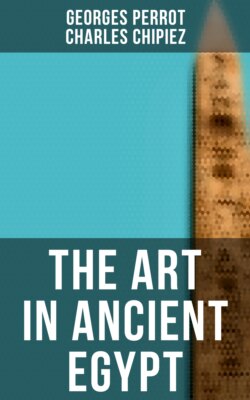Читать книгу The Art in Ancient Egypt - Perrot Georges - Страница 12
На сайте Литреса книга снята с продажи.
VI.
ОглавлениеTable of Contents
In the single edition of his great work which appeared during his own lifetime, Winckelmann inserted but a small number of illustrations, and those for ornament rather than for instruction. One of his translators, M. Huber, tells us that their execution gave great dissatisfaction to the author.[35] In our days, on the other hand, those who undertake a work of this kind make use of the great progress which has taken place in engraving and typography, to insert numerous figures in their text, to which they offer an indispensable and animated commentary. Without their help many descriptions and observations might remain unnecessarily obscure and doubtful. When forms are to be defined and compared, mere words, in whatever language spoken or written, can never suffice.
With well chosen phrases we may awake the recollections of others, and give renewed life to any impression which they may have received from some striking natural phenomenon or some fine work of art. Their imaginations will call up for a moment some landscape, picture, or statue which has formerly charmed them. But if we wish to explain the complicated plan of some great building, its design and its proportions, the slightest sketch will be of more use than the longest and most minute descriptions. So it will, if we wish to make clear the characteristics which distinguish one style from another, the Assyrian from the Egyptian, the archaic Greek style from that of the Phidian epoch or of the decadence, an Ionic column from the Erechtheum from one of the same order treated by a Roman architect. Between the contour of a figure from a Memphite bas-relief and that of one from Nineveh, what difference is there? A tenth of an inch more or less, a slight difference in the sweep of a line in order to mark more strongly the junction of the thigh and the knee. If we placed three nude torsos side by side, one of the sixth century, another of the fifth century, and the third of the time of Hadrian, a practised eye would at once assign its true date to each, in accordance with the manner in which the skeleton was indicated under the flesh, and the muscles drawn over it and attached to it. Supposing that the same model had served all three artists, it would show in the one case a lively sentiment of form combined with some dryness and rigidity; in another a freer, larger, and more subtle treatment, and in the third a want of vigour and firmness: but it would be difficult to give by words a clear idea of what caused the difference. Between the contour which satisfies us and that which does not there is hardly the difference of a hair; by leaning a little harder with the chisel the aspect of the one surface might have been made identical with the other. By its double astragali, by the fine chiselling of its gorgerin, by the elegant curve which unites the two volutes, and by the general delicacy of its ornament, a capital from the Erechtheum is distinguished above a Roman Ionic capital; it is at once finer in design and richer in ornamentation: by the side of it a capital from the theatre of Marcellus or the Coliseum would look mean and poor.
The whole history of art consists of the succession of subtle changes like these, and it would be impossible to convey them to the reader by the utmost precision of technical language or the most brilliant and life-like descriptions. The best thing that can be done is to make one's remarks in the presence of the statues, pictures and buildings concerned. But it is rarely that we find ourselves in such favourable conditions for teaching and explaining our ideas. But, in default of the objects themselves, we may at least give the most faithful images of them which can be obtained, and that we shall attempt to do throughout the course of this history.
We shall, then, give a large number of figures, in which absolute accuracy and justice of proportion will be aimed at rather than picturesque effects. It is not very long since, in collections of drawings from antique remains, they were all presented under one aspect, so far as the subtleties of style were concerned. The hand of the engraver spread a technical uniformity over them all in which differences of school and date disappeared, just as the delicate carvings and coloured ornament of the middle ages and the renaissance, which gave to each building an individuality of its own, were reduced to dull monotony by the undiscriminating brush of the whitewasher. It seemed to the artist natural enough to clothe the monuments of the past in the style of his own day—and it required much less care than would have been needed for the successful expression of all the diversities of style in his models. We have now, however, grown more exacting. We demand from the draughtsman who pretends to interpret a work of art the same devotion and the same self-sacrifice as from the writer who is charged with the translation of a work of literature from one language into another—we require him to forget himself, so that we may say of him, as the Latin poet says of his Proteus:
